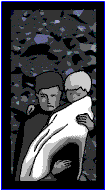The Disaster at Aberfan, Merthyr Tydfil, Wales
Created | Updated Jun 29, 2014

Friday, 21 October, 1966, an otherwise normal day, was destined to become the blackest day in the history of the country of Wales, UK.
A close-knit community living in a village named Aberfan, in the county of Merthyr Tydfil, South Wales, consisted of mainly coal miners and their families. The village lay in a valley, at the base of a mountain. On the mountain were slag heaps of huge amounts of coal waste from nearby mines. 600 feet below the top of the mountain lay Pantglas Junior School.
The Disaster
The primary cause of the disaster was an underground spring beneath the tip. This spring was well known by locals but the NCB denied all knowledge of it. Two days of heavy rainfall had loosened the slag from the the Merthr Vale Colliery and half a million tons of coal waste descended in the direction of the school. Inside the school, morning assembly had just been completed and the children were heading for their first class of the day. The black, billowing mass, 40 feet high, demolished a terraced row of houses, a farm and engulfed the school. Parents and colliery workers, as well as the rescue services, dug frantically to try and locate survivors.
A total of 144 people perished; 28 adults and 116 children. One teacher was found shielding a child with her body. A mass funeral was held on 25 October. The children, mostly aged between seven and ten years, are all buried in separately-marked graves on the hillside.
The Disaster Fund
The Mayor of Merthyr immediately launched a disaster fund to aid the village and the bereaved. Donations poured in from all over the world. The fund's final total was approximately £1,750,000, when it closed in January 1967. Some of the money was donated directly to bereaved families, a sum of £50 each. The fund also paid for house repairs, a community hall, and a memorial to the victims. More money was spent on giving the families a holiday. As the National Coal Board refused to accept full financial responsibility for the disaster, the fund ended up having to contribute £150,000 for the removal of the remaining tips overlooking the village. Although this provoked outrage at the time, it was not until 1997, over 30 years after the disaster, that this money was refunded.
Aftermath
The tragic accident at Aberfan led to the Mines and Quarries (Tips) Act (1969) and the 1971 Regulations. These charge quarry owners with securing the safety of solid and liquid tips and provide for design, supervision, inspection, notification, records and the making of tipping rules. The 1969 Act also places duties on local authorities in respect of disused tips.
Survivors
Nowadays, survivor guilt is a recognised condition and grief counselling is offered to the bereaved and all involved. This was not the case in 1966. Men then were expected to bear their grief 'like men' and not show 'weakness'. Parents remarked that they only had to see the surviving children growing up to be constantly reminded of what they had lost. In 1986, a newspaper ran a story, '20 years On' about the disaster. The villagers commented that they should have waited 50 years. Her Majesty Queen Elizabeth II visited Aberfan a couple of times and wept while talking to bereaved mothers. The Queen did not visit Aberfan immediately after the disaster but the villagers welcomed her later visits and thanked her for coming.

